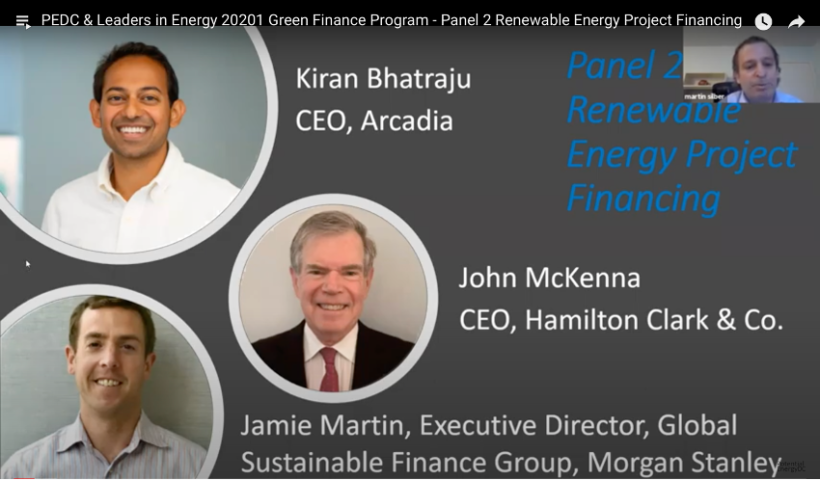
By Lara Batrack Baptista
7th Annual Green Finance Forum, Jan 21, 2021
PEDC & Leaders in Energy Green Financing: Panel 1 Report
The 7th annual Green Financing Forum, co-hosted by Potential Energy D.C. (PEDC) and Leaders in Energy, was held virtually on the 21st of January 2021. This year’s event edition, “Green Finance for Clean & Sustainability Technology”, took place on the day after Joe Biden was sworn in as President of the United States and signed an executive order to rejoin the Paris accord. With this, the new president signals the commitment to the climate agenda which makes this an opportune moment to resume the debate around finance models and instruments available to climate technology companies.
The event started with a keynote speech by Dr. Lynn Abramson, President of Clean Energy Business Network, who delivered a presentation on the policy outlook under the new administration. She highlighted the current policy opportunities available to companies, which includes the consolidated appropriations act of December 2020 that increased funding for Department of Energy (DOE) projects in 2.7% in 2021; the new tax credit for offshore wind, waste heat to power and second-generation biofuel; and the Energy Innovation Title that authorizes R&D in several key areas, such as, storage and energy efficiency, amongst others. She also added that advances on the Congressional Climate Plans should be seen from the third quarter of this year. Lynn concluded her presentation by saying that the number of climate experts and advisors nominated by this administration sets the tone for the next four years, which is that climate is a big priority.

The second panel of the event, Renewable Energy Project Financing, brought together representatives from the finance, energy, and consultancy sectors to debate the challenges and opportunities for the energy transition. The panel was moderated by Martin Silber, Chair of the Green Finance Working Group at Leaders in Energy and had as speakers, Kiran Bhatraju, CEO of Arcadia; Jamie Martin, Executive Director at Morgan Stanley’s Global Sustainable Finance group and John McKenna, CEO of Hamilton Clark Sustainable Capital.
The moderator, Martin Silber, opened the panel proposing a look at the trends and innovative financial models used in financing renewable energy projects. He mentioned that Biden’s 1.7 trillion dollars climate plan, as well as individual companies pledges to achieve carbon neutrality by 2040, a decade earlier than the Paris Agreements goal, is dependent on 100% clean energy matrix and leveraging the capital market, which raises the question, is there adequate financial models and instruments to meet this ambitious plan of clean energy, sustainability, and climate goals?
Kiran Bhatraju, CEO and founder of Arcadia
Kiran Bhatraju, the CEO and founder of Arcadia, started off by saying that Arcadia is an energy company with a unique and innovative business model that faced many obstacles in the first years. As a digital utility, based in Washington D.C., Arcadia developed a technology platform, which provides clients with easy access to clean energy.
One of the platform’s main product is community solar, which is a large-scale distributed generation solar plant, ranging from 2 MW to 10 MW, that sells the energy to the client at a rate lower than the utility. This product is great for clients that cannot install a solar panel on the roof and because it’s easy and frictionless. It does not require credit check; it has no cancellation penalties, nor a long-term contract. Overall, Arcadia has financed close to 500MW of community solar and is looking to continue growing now that the financial sector is more used to their model.
Despite the positive momentum, in early days, Arcadia was not successful. It demanded lots of determination and bold decisions to get where they are now. Kiran said that the first challenge was to explain to investors that solar community projects had a different nature than solar rooftop, which was more developed at that time. Kiran says that bringing data to the table was essential to prove that the company had a great product and break the initial barrier. To achieve that, the company had to take significant earn cuts, in the first projects, to be able collect enough data to show investors that the model did work and that the clients did pay the bill.
According to Kiran, in the financial market, once one investor has a good experience with your project, other institutions will be more likely to invest in your business. Investors want to know that they will have return and that the business is reliable. After that, it was easier to unlock tax equity investments. After the first project, each subsequent portfolio project, we got better conditions. Kiran added that, in the early days, one of Arcadia’s first projects was funded by a high net-worth individual. It was not an ideal situation, but it worked out as the company was able to collect data that then led to new projects being funded.
Jamie Martin, Executive Director at Morgan Stanley’s Global Sustainable Finance group
Jamie Martin, Executive Director at Morgan Stanley’s Global Sustainable Finance group, spoke about how Morgan Stanley advises companies on how to adapt to the new times, when companies are no longer being evaluated only by their finance performance but also by the environmental, social and governance (ESG) performance. According to him, the capital market is bringing tools from equity and debt side to scale up investment in renewable energy. On the policy side, Europe is leading on how policy can set the agenda for a more sustainable and just economy and the U.S should follow on the same path.
Jamie spoke about financial instruments available in the market. According to him, the use of green bonds is growing and expanding to companies in the entire credit spectrum. Green bonds are fixed income instruments, which uses the proceeds for to sustainable projects.Although there were many questions around green washing, green bonds have got around criticisms, reaching an overall issuance of 350 billion dollars in 2020. He added that these products are constantly oversubscribed which is an indication of the market’s appetite.
Another product mentioned by Jamie is the sustainability-linked bonds, which is a general corporate purpose which has an embedded sustainability key performance indicator (KPI). If the issuer does not meet the target, then the company will have to pay more to the buyer. In 2019, Italian electricity company, Enel, issued a 2.5 billion euros sustainability-linked bond in the European market. He also added that he expects to see the same occurring across carbon intensive sectors in the next years. He concluded him presentation saying that the scale of green bonds issued is important as these are benchmark billion dollars transactions but that it is also possible to see smaller companies with strong projects also using this green bonds as source of financing their projects.
John McKenna, CEO of Hamilton Clark Sustainable Capital
John McKenna, CEO of Hamilton Clark Sustainable Capital, was founded in 1900’s in Houston, and started-off working mainly with energy projects related to the oil & gas sector. For the last ten years, the company has focused exclusively in helping clean energy technology companies to raise capital at the corporate or project level. Hamilton Clark works with the client to get the technology mature and deploy it in projects. John explained that half of the business is financing, and the other half focuses on mergers and acquisition, specialized in several sectors, such as, food tech, transportation and a wide range of renewable energy technologies. The company has 14 managing directors in 8 cities, including one in Zurich, focused in developing the European market.
As a company specialized in advising clients on how to raise capital, John kicked off by saying that the first step is to decide at what level the money will be raised, at corporate level and deployed into the business or build first the project to shield the company. As a rule, they generally advise their clients to go for the project debt option. In case that is not possible, they will raise capital at corporate level. The next step is to mitigate the risks in case they go for that option, but they try to get private debt funds to take the risk whenever is possible. He concluded that private debt funds are willing to take more risk by taking a senior secure position in the project or companies., which is a good sign for the future.
Lara Baptista is an energy economy and policy specialist who worked for over 10 years providing advice for foreign companies in Brazil and managing International cooperation projects in the Low Carbon sector. She holds a master’s degree in Global Energy Transition and Governance by the Centre International de Formation Européenne, and an MBA in Energy Economy by COPPEAD.



Leave a Reply